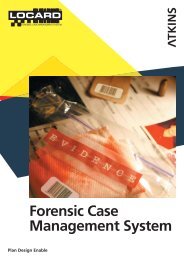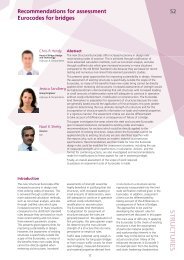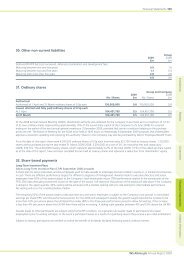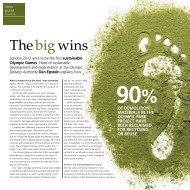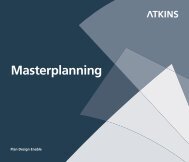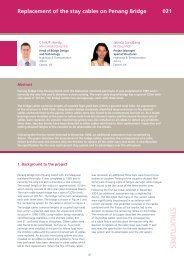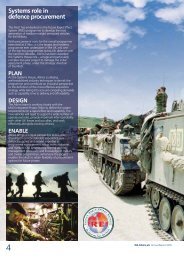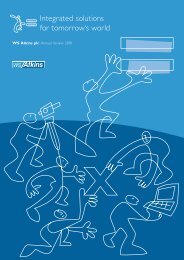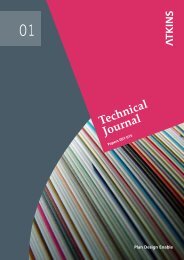View - Atkins
View - Atkins
View - Atkins
You also want an ePaper? Increase the reach of your titles
YUMPU automatically turns print PDFs into web optimized ePapers that Google loves.
72 Financial Statements<br />
Notes to the Financial Statements<br />
Continued<br />
Acquired customer relationships<br />
Acquired customer relationships consist of intangible assets arising on the consolidation of recently acquired business, principally future<br />
order books, that do not appear within the balance sheet of the acquired entity itself, and which are separable from goodwill in<br />
accordance with IFRS 3, Business Combinations and IAS 38, Intangible Assets. Customer relationships are amortised on a straight-line<br />
basis over their useful economic lives of between one and three years.<br />
Corporate information systems<br />
In accordance with IAS 38, Intangible assets, the Group’s corporate information systems are treated as an intangible asset. Costs<br />
included are those directly attributable to the design, construction and testing of new systems (including major enhancements and<br />
internally generated costs) from the point of inception to the point of satisfactory completion where the probable future economic<br />
benefits arising from the investment could be assessed with reasonable certainty at the time the costs are incurred. Maintenance and<br />
minor modifications are expensed in the income statement as incurred. The corporate information systems are amortised on a straightline<br />
basis over their estimated useful economic life of six years.<br />
Software licences<br />
Acquired computer software licences are capitalised on the basis of the costs incurred to acquire and bring into use the specific<br />
software. These costs are amortised on a straight-line basis over their useful lives of between two and five years.<br />
Property, plant and equipment<br />
Property, plant and equipment is carried at cost less accumulated depreciation and impairment. Cost comprises purchase price after<br />
discounts and rebates plus all directly attributable costs of bringing the asset to working condition for its intended use.<br />
Property, plant and equipment is depreciated on a straight line basis calculated at annual rates to write off the cost less residual value<br />
of each asset over the term of its estimated useful economic life as follows:<br />
Freehold buildings<br />
Short leasehold<br />
Plant and machinery<br />
Special purpose industrial motor vehicles<br />
Other motor vehicles<br />
Information technology<br />
10 to 50 years<br />
over the life of the lease<br />
3 to 10 years<br />
3 to 12 years<br />
3 to 4 years<br />
2 1 ⁄2 to 5 years<br />
No depreciation is provided in respect of freehold land.<br />
The directors annually review the estimated useful economic lives and residual values of property, plant and equipment.<br />
Impairment<br />
Assets that have an indefinite useful life are not subject to amortisation and are reviewed for impairment annually and when there are<br />
indications that the carrying value may not be recoverable. Assets that are subject to amortisation are reviewed for impairment wherever<br />
events or changes in circumstances indicate that the carrying amount may not be recoverable. An impairment loss is recognised for the<br />
amount by which the carrying amount of the asset exceeds its recoverable amount. The recoverable amount is the higher of the fair<br />
value less costs to sell and value in use. For the purposes of assessing impairment, assets are grouped at the lowest levels for which there<br />
are separately identifiable cash flows (cash-generating units).<br />
Investments in subsidiaries<br />
Investments in subsidiaries are stated at cost less impairments.<br />
Financial assets<br />
The Group classifies its financial assets into the following two categories: at fair value through profit or loss and loans and receivables.<br />
Financial assets at fair value through profit or loss<br />
These include fixed interest securities, floating rate notes and certificates of deposit which are valued at bid price quoted on a recognised<br />
stock exchange. Debt securities issued at a significant discount to the maturity value are valued at cost plus amortised discount over the<br />
life of the security. Also included are restricted cash deposits where withdrawals are restricted under contractual arrangements. Changes<br />
in fair value are recognised in the income statement.<br />
Loans and receivables<br />
Loans and receivables are non-derivative financial assets with fixed or determinable payments that are not quoted in an active market.<br />
They are included within current assets except where the maturity is greater than 12 months after the balance sheet date in which case<br />
they are included as non-current assets. The Group’s loans and receivables consist of trade and other receivables and cash and cash<br />
equivalents, which are shown separately within the balance sheet. Trade receivables are recognised at original invoice amount less<br />
provision for impairment, which, due to their short-term nature, approximates to their fair value.<br />
WS <strong>Atkins</strong> plc Annual Report 2008



